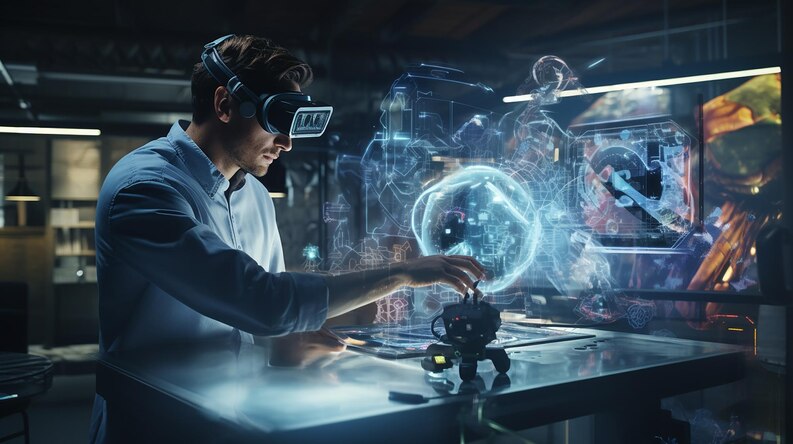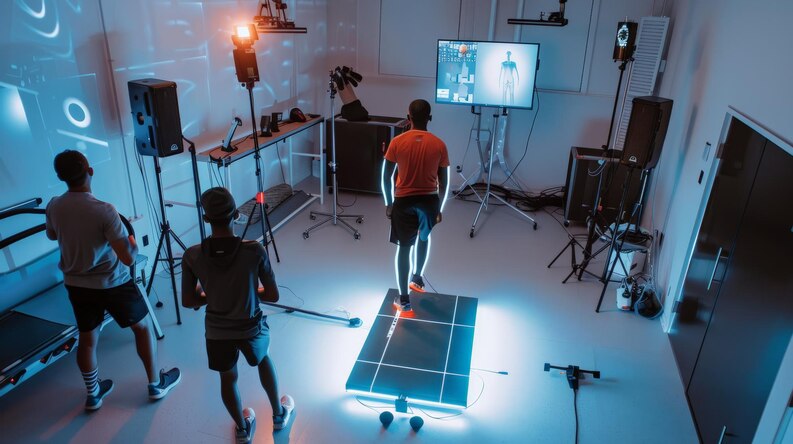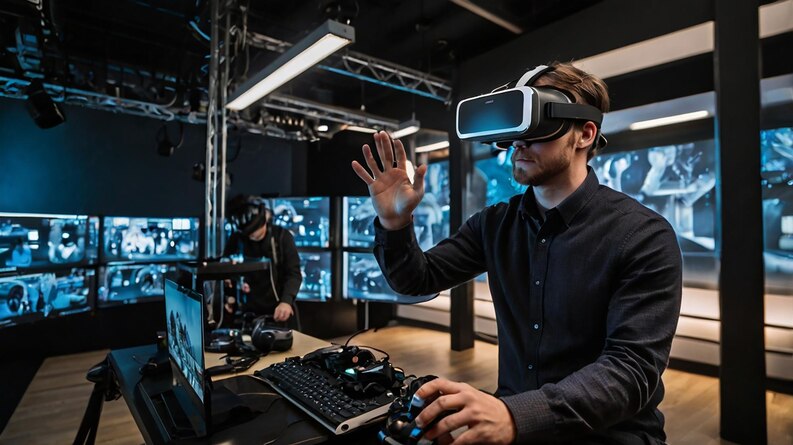The filmmaking industry is in the midst of a transformative revolution, driven by the advent of virtual production technologies. This cutting-edge method blends traditional filming techniques with real-time rendering, advanced computer graphics, and motion capture technology, creating a hybrid approach that is reshaping the way films, television shows, and advertisements are produced. Virtual production offers unparalleled creative freedom, efficiency, and cost-effectiveness, opening new avenues for storytelling and visual effects. In this post, we will delve into the different types of virtual production, each uniquely contributing to the evolution of modern filmmaking.
Real-Time Rendering and In-Camera VFX
One of the most significant advancements in virtual production is real-time rendering and in-camera visual effects (ICVFX). Utilizing powerful engines such as Unreal Engine and Unity, real-time rendering allows for the creation of highly realistic digital environments and assets that can be visualized during the shoot. This immediate feedback loop provides filmmakers with the ability to see the final visual effects as they are being captured, making on-the-fly adjustments possible.

In-camera VFX combines real-time rendering with practical in-camera effects, where digital backgrounds and elements are displayed on LED walls. This technology eliminates the need for green screens and post-production compositing, enabling actors to interact directly with the digital environments. Filmmakers can adjust lighting, camera angles, and even the digital set itself in real time, offering unprecedented creative control and flexibility.
For example, a production studio in London can leverage in-camera VFX to create a scene set in an alien world, with actors engaging with interactive digital elements projected onto LED screens. This method not only enhances the realism of the scene but also provides a more immersive and authentic experience for the actors, resulting in more genuine performances.
Motion Capture and Performance Capture Techniques
Motion capture (mocap) and performance capture are integral components of virtual production, enabling the creation of lifelike digital characters and animations. Motion capture involves recording the movements of actors using specialized suits equipped with sensors, which are then mapped onto digital characters. This technology is widely used in creating realistic animations for films, video games, and virtual reality experiences.
Performance capture takes motion capture a step further by capturing both the physical movements and facial expressions of actors. This technique is especially valuable in creating digital characters that require human-like performances, as it ensures that every nuance of the actor’s performance is translated into the digital counterpart. The real-time feedback provided by performance capture allows directors to make immediate adjustments, ensuring that the final animation aligns closely with the creative vision.
An example of performance capture in action can be seen in films like “Avatar” and “The Lord of the Rings,” where actors’ performances were captured and transformed into realistic digital characters, bringing fantastical creatures to life with unprecedented detail and authenticity.
Virtual Set Extensions and Environment Creation
Virtual set extensions involve combining physical sets with digitally created backgrounds and environments, seamlessly blending the real and digital worlds. This type of virtual production allows filmmakers to expand the scope and scale of their scenes without the limitations of physical space. By using virtual set extensions, filmmakers can create elaborate and expansive environments that would be impractical or impossible to build in real life.
Environment creation, on the other hand, involves the complete creation of digital environments that actors can interact with. These environments can be photorealistic or stylized, depending on the needs of the narrative. Virtual production studios in London, for instance, are at the forefront of using virtual set extensions and environment creation to produce visually stunning and immersive content.
The ability to create detailed digital environments allows filmmakers to explore new visual styles and storytelling techniques. For example, a historical drama can recreate ancient cities with remarkable accuracy, while a sci-fi film can invent entirely new worlds with unique landscapes and architecture. This creative flexibility expands the possibilities of visual storytelling, enabling filmmakers to push the boundaries of their craft.
Previsualization and Virtual Scouting Tools
Previsualization (previs) is a powerful tool in virtual production that involves creating detailed digital previews of scenes before they are filmed. Previs allows filmmakers to plan and visualize the composition, camera angles, lighting, and movement of scenes in a virtual environment. This process helps in identifying potential challenges and refining the creative vision before the actual shoot, saving time and resources.
Virtual scouting is another valuable tool, enabling filmmakers to explore and evaluate digital locations without the need for physical travel. Using virtual reality (VR) and augmented reality (AR) headsets, directors and production designers can walk through virtual sets, assess different angles, and make necessary adjustments. This real-time exploration of digital environments aids in efficient decision-making and enhances the overall production workflow.
For example, a director can use virtual scouting to evaluate a digitally created cityscape, determining the best camera positions and movement paths. This virtual exploration ensures that every detail is meticulously planned, resulting in a more streamlined and efficient production process.
Live Production and Real-Time Editing Integration

Live production and real-time editing are integral aspects of virtual production, facilitating a more dynamic and interactive approach to filmmaking. Live production involves streaming real-time rendered footage directly to monitors during the shoot, allowing directors, editors, and VFX artists to see the final visual effects immediately. This immediate visualization enhances collaboration and enables creative teams to make informed decisions on the spot.
Real-time editing integration further streamlines the production process by allowing for immediate editing and compositing of scenes. Filmmakers can preview and make changes to the footage during the shoot, reducing the need for extensive post-production work. This integration ensures that the final product aligns closely with the director’s vision and meets the highest standards of quality.
For example, during a live production shoot, a director can see the final composite of a scene with digital elements integrated in real-time. This immediate feedback allows for adjustments to be made on set, ensuring that the visual effects are seamlessly integrated with the live-action footage.
The Future Trends and Innovations in Virtual Production
As virtual production technology continues to advance, new trends and innovations are emerging, further expanding the possibilities of filmmaking. The integration of artificial intelligence (AI), machine learning, and augmented reality (AR) is poised to revolutionize virtual production, offering new tools and techniques for creating immersive and interactive experiences.
AI-driven algorithms can analyze large datasets to generate realistic visual effects, optimize lighting conditions, and even assist in scriptwriting and storyboard creation. Machine learning can enhance motion capture and performance capture techniques, enabling more accurate and lifelike animations.
Augmented reality (AR) is another exciting trend, offering new ways to blend digital elements with the physical world. AR can be used to create interactive advertisements, enhance live performances, and provide viewers with immersive experiences that extend beyond the screen.
The continued evolution of virtual production technology is likely to democratize filmmaking, making high-quality production tools accessible to independent creators and small studios. By embracing these advancements, filmmakers can push the boundaries of their craft, creating visually stunning and engaging narratives that captivate audiences.
Conclusion
Virtual production is a multifaceted and dynamic field that is reshaping the future of filmmaking. From real-time rendering and in-camera visual effects to motion capture, virtual set extensions, and previsualization tools, the different types of virtual production offer unparalleled creative freedom, efficiency, and realism.
As technology continues to evolve, virtual production will play an increasingly central role in the filmmaking process, enabling filmmakers to create immersive and visually stunning content that pushes the boundaries of storytelling. By embracing the diverse and innovative tools of virtual production, filmmakers can unlock new possibilities and shape the future of cinema.
Whether you’re working in a cutting-edge virtual production studio in London or exploring the latest trends in AI-driven visual effects, the world of virtual production offers endless opportunities for creativity and innovation. The future of filmmaking is undoubtedly intertwined with virtual production, and those who embrace its potential will be at the forefront of this exciting and transformative era.

